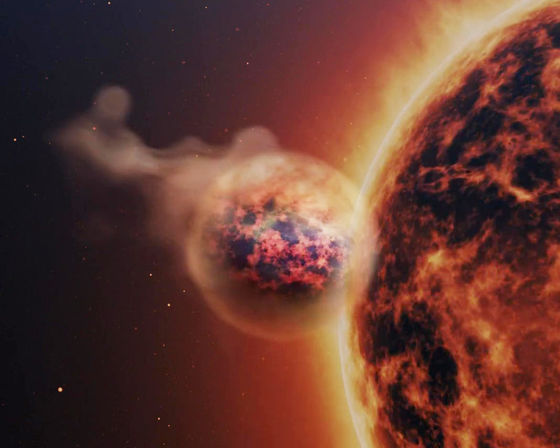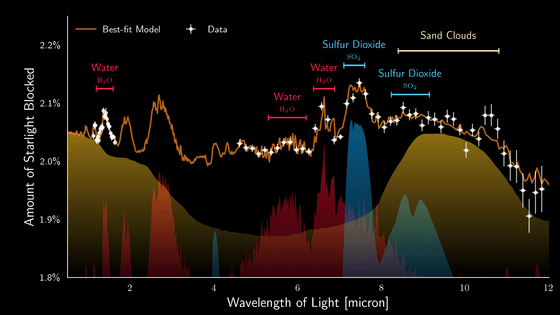NASA's James Webb Space Telescope discovers ``planet with sand rain''

The gas planet
SO2, silicate clouds, but no CH4 detected in a warm Neptune | Nature
https://www.nature.com/articles/s41586-023-06849-0
James Webb Space Telescope detects water vapor, sulfur dioxide and sand clouds in the atmosphere of a nearby exoplanet - News
https://nieuws.kuleuven.be/en/content/2023/jwst-detects-water-vapour-sulfur-dioxide-sand-clouds
Planet where it rains sand revealed by Nasa telescope | Planets | The Guardian
https://www.theguardian.com/science/2023/nov/15/planet-where-it-rains-sand-revealed-by-nasa-telescope-wasp-107b
WASP-107b is a planet discovered in 2017 using the transit method , which utilizes the phenomenon in which light is blocked when a planet passes in front of its host star. It is located approximately 200 light-years from Earth in the constellation Virgo.
WASP-107b has received the nickname 'cotton candy planet' from astronomers because it is similar in size to Jupiter but weighs about as much as Neptune, and has the lowest density of any known planet. Ta.
'It's really fluffy, so it's a perfect observation target. When you look at the atmosphere of such a fluffy planet, you can get a lot of signals. I've been working on predicting the shape of this star for 10 years. But it's still not as good as actually observing it,' says Joanna Barstow, who is working on an observation project using the James Webb Space Telescope at Britain's Open University.

A new study published in the scientific journal 'Nature' in November 2023 analyzed the light that passed through WASP-107b's thick atmosphere with the James Webb Space Telescope, and found that WASP-107b has a main component of sand. The findings included silicate clouds and rain, raging hot storms, and an atmosphere containing water vapor and sulfur dioxide, the smell of struck matches.
What is noteworthy is that WASP-107b is less dense and 'fluffy' than ordinary gas planets. This allowed astronomers to analyze WASP-107b's atmosphere 50 times deeper than Jupiter. Clouds exist on various planets, but this is the first time that the chemical composition of clouds on another planet has been determined in detail.
WASP-107b's atmosphere has a cycle similar to Earth's water cycle , but instead of water, silicates circulate as solids, liquids, and gases. First, silicate vapor rises from the lower layers of WASP-107b's atmosphere, where temperatures are close to 1,000 degrees Celsius, and cools down to become invisible grains of sand. When this dust cloud becomes thick enough, it rains sand into the lower atmosphere. This silicate sublimes back into steam, starting the sand cycle again at WASP-107b.
Other findings from the analysis included that while water was detected, methane was absent. The absence of methane suggests that the planet's interior may be warm. Additionally, sulfur dioxide was present in WASP-107b, although it was thought that sulfur dioxide would not be produced in previous models. The research team speculates that WASP-107b's unique 'fluffy nature' allows the star's light to reach deep into the planet, where enough chemical reactions occur to produce sulfur dioxide. .

The main mission of the James Webb Space Telescope is to analyze the atmospheres of planets far from Earth to find 'biosignature gases' that indicate the presence of life, but unfortunately WASP is a hot planet with no solid surface. -107b is not considered a promising candidate.
Rocky Earth-sized planets are also more difficult to analyze because even if they do have atmospheres, they tend to be thin and dense. However, obtaining detailed data from a distant planet like WASP-107b is also an encouraging precedent.
'The universe is full of surprises, and I imagine there are many ways for life to emerge on other planets,' said one of the study's authors, Leanne Deschin of the Institute of Astronomy at the Catholic University of Leuven. 'Maybe it's completely different from anything known on Earth. We'll have to stretch our imaginations even further.'
Related Posts:
in Science, Posted by log1l_ks







